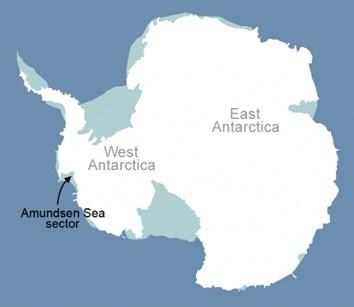Create a free profile to get unlimited access to exclusive videos, sweepstakes, and more!
West Antarctic Glacier Slow-Speed Collapse May Be Unstoppable

Scientists studying huge glaciers in Antarctica have found that they are already in the early stages of a huge retreat, and—although the entire event may take more than 200 years—this melting may also be unstoppable. By the time this plays out, it could cause a sea level rise of more than a meter, which would be very bad indeed. And the culprit for this: warmer waters in the Antarctic oceans, due to human-induced global warming.
Note: One word being used for this event is “collapse,” which has connotations of a rapid, catastrophic event. However, in the scientific sense here it means the end-game event of the rapid melting of a glacier. In a geologic sense it is fast, but we’re talking a few centuries here. I want to be very clear here, as I’m sure this word will get abused by talking heads in the media.
The glaciers are located in the western Antarctic and feed into the Pine Island Bay, which leads to the Amundsen Sea. These glaciers flow into the bay, creating ice shelves that float on the water. The line where the ice leaves the land and floats on the water is called the grounding line. Warm water has been melting the underside of the floating ice, which has been pushing the grounding line farther inland. The scientists put together a short video to show this:
Up until recently it’s been difficult to understand just what is going on under the glacier, including the exact position of the grounding line. The scientists used radar data to measure the way the ice moves to find it. As the ice moves from land to sea, it floats on the water. As the tides go up and down, the ice moves up and down with it, and this allows them to determine just where the ice moves out into the water—the grounding line. Over time, the grounding lines are moving inward, which increases the water’s ability to melt the ice.
We’ve known for some time these glaciers are melting. The new study is based on 40 years of observations of the glaciers, and it pinpoints that flow, shows how rapid it is, and also predicts the future melting.
The real problem is that we may already be past the point of no return: The collapse may be inevitable, unstoppable.
The terrain under the glaciers is part of the key here. The Antarctic ice lies over solid ground, which has valleys and ridges. Ridges can support the ice, keeping it from melting as fast, for example. They can also block the flow like a dam. However, observations mapping the solid ground under the ice show no such formations exist. In other words, there is nothing preventing the ice from flowing into the sea.
I’ll note that a second team of scientists studying the same area get very similar results using computer models of melting of these glaciers. They find that the glaciers are already in a state of collapse, that melting will increase over time, and that the end stage will happen in 200–900 years … more likely at the shorter end of that scale.
Simulations using the data collected show that the glacier melting will contribute something less than a millimeter of sea level rise per year for the next century or two, and then at that point the collapse accelerates and the whole thing lets go, probably only taking a few decades.
Their data clearly show that a major cause of this is warmer water in the oceans, which obviously is better at melting ice. We have known for some time that the oceans temperatures are on the rise due to global warming, and this is one consequence. There are other more complicated factors as well, including the way winds blow, but the overall effect all points one way: The inevitable collapse of these enormous deposits of ice.
Despite all this evidence, I’m sure there will be claims by the usual suspects that Antarctic ice is actually increasing, not decreasing. However, this is misleading at best (and I'm being kind here).
Why? There are two kinds of ice in Antarctica. One is sea ice, and the other land ice. Sea ice is just what freezes in the winter and melts in the summer; it varies with the seasons, and that amount fluctuates year by year as well, but over time is relatively constant. But that doesn’t affect the land ice.
Antarctic land ice is decreasing by an astounding 100 billion tons per year. That’s what we’re talking about here. Sea ice in Antarctica isn’t important in the long run when it comes to climate change; land ice is. And we’re losing land ice at a stunning rate.
The effects of sea level rise are profound. We don’t have to wait decades or centuries for the coastlines to change; some of these effects are happening now and are quite large. For example, higher levels mean more flooding, especially during storm events. Big low pressure systems (like hurricanes, or the “superstorm” Sandy from 2012) bring a big surge of water inland from the ocean, and a rise in sea level increases the size of the surge; in the case of Sandy it caused flooding in lower Manhattan.
All in all, this is yet another piece in a long, long chain of evidence showing that the planet is warming and the effects of this change are vast and far-reaching. And it may seem like this particular case of Antarctic melting won’t affect us for decades, or even centuries, but don’t be fooled. The effects of this are happening now, and we need to take them seriously.


























